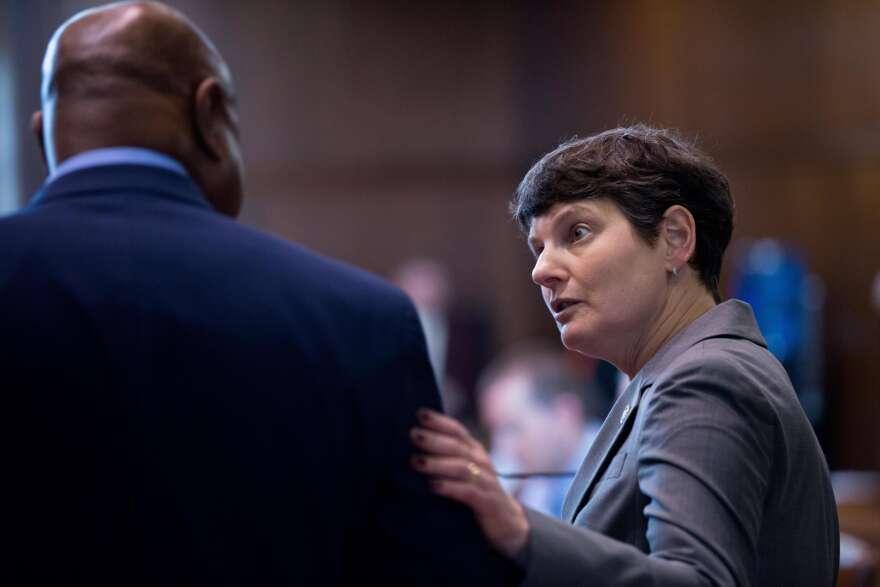The state’s top budget writers unveiled their priorities for Oregon’s next two-year spending plan on Thursday, arguing that a shaky economic outlook demands the state focus on core areas of concern.
Key to the budget framework released by state Sen. Elizabeth Steiner and Rep. Tawna Sanchez, both Portland Democrats, are continuing investments in K-12 education, health care for low-income Oregonians, and housing and homelessness. All are areas where spending has swelled in recent years.
Left uncertain in the document is where Oregon will come down on issues that need additional attention, such as the state’s public defense crisis or whether Oregon will put $1 billion toward a new Interstate 5 bridge over the Columbia River.
The budget chairs said Thursday they want to avoid implementing new programs that require ongoing spending and would ask state agencies to hold some vacant positions open to rein in costs.
“None of these are easy choices,” said Steiner, who like Sanchez serves as co-chair of the Legislature’s Ways and Means Committee. “This is not an easy time to be a budget chair.”
The budget framework reveals how the two chairs are thinking about spending the roughly $31.6 billion in general fund and lottery revenues the state is expected to have at its disposal from 2023 to 2025.

That amount will almost certainly change before lawmakers approve a final spending plan in June. A revenue forecast due in May will serve as the final say in how much money the state expects to bring in. State economists have warned repeatedly that a recession could lie in wait, as the Federal Reserve looks to tamp down inflation by hiking interest rates.
Still, the framework is a traditional opening salvo as budget talks heat up in Salem. Sanchez and Steiner suggested in the document they agree in large part with priorities Democratic Gov. Tina Kotek set in her own budget proposal in January: education, behavioral health and housing.
“We’re creating this budget in a time of great economic uncertainty,” Steiner said. “Our priority is to protect the vital services that Oregonians depend on, especially the most vulnerable Oregonians.”
Like Kotek, the budget chairs are proposing putting $9.9 billion toward funding K-12 education in the state, up from $9.3 billion in the current budget. That’s a number that will be debated as lawmakers work toward finalizing a budget. While Steiner, Sanchez and Kotek all argue that their figure represents a $400 million investment above paying for current services, state education officials warn it actually would force “widespread cuts.” They have proposed $10.3 billion instead.
Steiner and Sanchez are also putting an emphasis on health care spending. Their plan includes $10.7 billion toward human services programs, which will go in large part toward continuing to fund investments lawmakers have made in past budgets. The proposal amounts to a slight reduction in the $10.8 billion state budget analysts have calculated would pay for current services, but Sanchez and Steiner said they are prioritizing necessary expenses.
“Looking back at the things that we passed, we really need to move those things forward,” Sanchez said. “That’s why there isn’t really a whole lot of room for a whole lot ... We really want to just ensure that we take care of just the base needs.”
Throughout their proposal, the budget chairs emphasized how much state spending has ballooned since the outset of the COVID-19 pandemic — driven largely by federal aid, but also booming state tax revenues.
With all funding streams accounted for — including federal funds — the amount required to pay for current state services in the 2023-25 budget is more than 25% higher than that amount in the 2019-21 budget, an increase of $27 billion. The rise has been driven by increased spending on education, health care, housing and wildfire response, among other things.
“People have become accustomed to having lots and lots and lots of resources,” Steiner said. “The combination of the uncertain economy and inflation are putting us in a very different place than we were two or four years ago.”
Other notable aspects of the budget framework:
Kotek on Thursday called the budget document put forward by lawmakers “a thoughtful approach.”
“We share a mission-focused vision: rather than scores of new programs, we need to prioritize investments that will deliver meaningful results on housing and homelessness, behavioral health, and education,” the governor said in a statement. “As the budget process moves forward, I urge the legislature to exhaust every possible funding option in order to make the visible and measurable progress that Oregonians are demanding on these issues of statewide concern.”
Sanchez and Steiner acknowledged that their framework is only a first draft of what their ultimate budget will look like. And importantly, the document does not contain proposals for how the state will spend hundreds of millions of dollars it can borrow by issuing bonds.
Kotek, in her proposed budget, signaled she would prioritize bond proceeds to spend $770 million on affordable housing. But the state has many competing interests for the cash, including $1 billion that Washington state lawmakers have said they expect Oregon to contribute toward a new I-5 bridge over the Columbia River.
Steiner and Sanchez said decisions about where to target bonding are still ongoing. They said they are unlikely to spend the entire $1 billion toward a bridge replacement in this budget.
Copyright 2023 Oregon Public Broadcasting.



